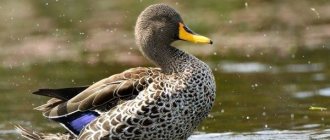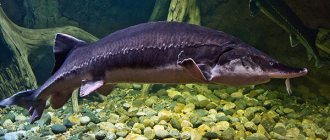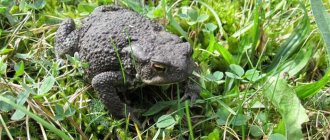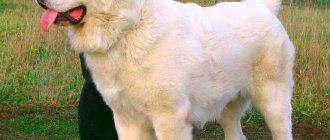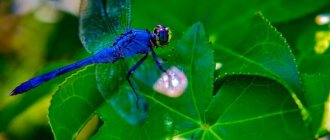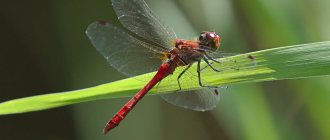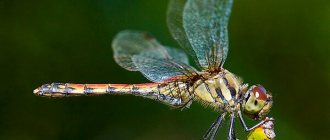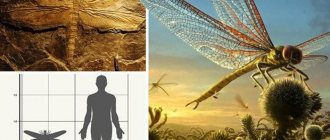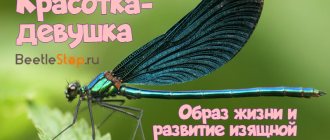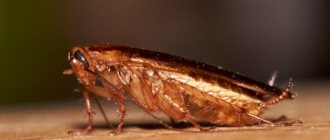A large, motley-colored dragonfly with rapid, maneuverable flight, capable of flying tens and hundreds of kilometers, a formidable hunter who feeds on everything that he can overcome - this is how the Emperor’s watchman can be briefly described.
The Emperor Watcher is a large, motley-colored dragonfly.
Watchers belong to the family of rocker dragonflies. The genus Watchers includes four species and is identified by veins on the wings and spines on the hind legs.
BLUE EYES, LIGHT WINGS
The Emperor, also known as the Blue Emperor, also known as the Watchman-Overlord, is distinguished by his apple-green thoracic region and the bright blue color of his abdomen in males. A black jagged stripe runs along the abdomen. The picture is complemented by light gray wings, large blue-green eyes and spines on the legs, which form a “basket” for catching insects in flight.
This is not only one of the largest dragonflies, but also one of the most ferocious predators: not only adult “flyers”, but also amphibian larvae attack even fish fry. At the same time, watchmen cannot compete with dragonflies of the rocker genus if they live next to them.
The female Emperor's Watcher is green.
Lifespan
We have looked at some of the structural features of dragonflies, but it is also important to clarify that they can live up to ten years. These are real long-livers in the world of insects. Let's talk a little more about this
Let's talk about this a little more.
In total, there are more than 6.5 thousand species of these unusual, graceful and beautiful creatures on our planet. On the territory of Russia you can find a small number of species, about 150. So, the lifespan of dragonflies directly depends on the species, the minimum is two months, and the longest-livers can last about ten years. This period includes the full development cycle of insects, and the development of the larvae in some species can take more than one year.
The external structure of a dragonfly directly depends on the species. There are only three suborders of these insects:
How are they different? The first species has two pairs of wings, they are narrow and almost identical in shape. If the dragonfly is at rest, then both the front and rear wings are raised up and connected to each other. In the second case, the wings have a different shape and, at rest, are spread out to the sides. The third suborder includes a single genus; these insects are common in Japan and India. The peculiarity of the latter is also that they combine the characteristics of the first and second suborders.
The most common representatives of homoptera dragonflies:
- Beauties.
- Arrow.
- Lute Dryad.
- Megaloprepus caerulatus.
It is also very important to know that the last of these are the largest dragonflies in the world. Their body length reaches ten centimeters, and their wingspan reaches nineteen. Prominent representatives of the heteroptera suborder:
Prominent representatives of the heteroptera suborder:
- Watcher-emperor.
- Cordulegaster annulated.
- The headstock is metal.
- The grandfather is ordinary.
- Common dragonfly.
FROM SCANDINAVIA TO AFRICA
The Emperor is capable of presenting us with many surprises. It turns out that this is the most widespread species of dragonfly, living in all natural areas of the Earth - from Scandinavia to East Africa. True, even in the places of its distribution, the species is found quite locally: for the laying of eggs and the development of the larva - naiad - dragonflies need suitable reservoirs. In particular, watchmen are very picky about temperature conditions; the water must be warm enough; lowering its temperature limits their numbers.
Peony thin-leaved
A perennial plant growing in the European part of the country.
Thin-leaved peony can be found in the steppe zone, on rocky mountain slopes, forest edges and clearings. The height of the plant can reach half a meter. Peony leaves are thin and divided into feathers. Flowering occurs at the beginning of May. The color of the flowers varies from purple to blood red. The diameter of one flower is up to 8 cm. Terry specimens are rare. The plant is winter-hardy and drought-resistant, but does not bloom well in shaded areas. Due to the reduction in the area of the steppes, the number of peonies has sharply decreased. Today it can only be found in lands inaccessible for plowing. Another negative factor is grazing by livestock, which tramples the aboveground part of the plant. Also, thin-leaved peony suffers from massive collection and digging of rhizomes. Numerous populations have survived only in the territories of nature reserves.
NEAR THE WATER
The entire life of watchmen is connected with water bodies of forest landscapes - both open and closed. These dragonflies make their many-kilometer flights precisely in order to colonize new bodies of water. In mid-June, after the last molt, young dragonflies emerge. They are colored the same: the abdomen is green or bluish with brown markings, and the wings are dark. Over time, the wings lighten and become gray-white, and the abdomen of the males acquires its legendary blue-blue hue. The females remain greenish. Males and females behave differently: males remain near the water, and females prefer to feed on the edges of forests, in forest belts, and bushes. High speed (and it can reach 60 km/h), sharp vision (the eye of a dragonfly consists of 28 thousand facets, which is seven times more than that of a fly), quick reaction and an iron grip on the “basket” that their legs form, clasping prey, allow watchmen to catch even large and dangerous insects. And yet their main food is mosquitoes. During the mating period, each male chooses an individual area for himself and patrols it, not allowing strangers there: there he mates with his “chosen one” on the fly. Or rather, on the contrary, the female flying past catches up with the male and makes her her chosen one, and after three or four days she begins laying eggs. She lays eggs one at a time, on aquatic plants - pondweed and others. Therefore, it is important that the reservoir is sufficiently overgrown, stagnant or low-flowing. Typically, a female mates several times during her life.
Symptoms and consequences of a gadfly bite
Only one species of gadfly, Dermatobia hominis, which lives in the forests of Central America, uses humans as a “reservoir” for rearing larvae. After a bite, a disease called dermatobiasis develops, manifested in local inflammation, suppuration and the development of general intoxication phenomena. A bite from a human gadfly is rarely fatal. One case of death of a one and a half year old child with multiple infestations, that is, with the penetration of a large number of larvae under the skin, was registered.
More often, the death of children is associated with brain damage when the larvae penetrate inside the skull. In this case, symptoms such as swelling of the upper body, inflammation of the lymph nodes, and headache associated with increased intracranial pressure are observed. Fortunately, such a complication develops extremely rarely after a Dermatobia hominis bite.
In Russia, people become victims of gadflies extremely rarely: such cases occur sporadically, since all species living in our country parasitize farm and wild animals
However, females still lay eggs under the skin of people, so it is important to know the symptoms of infection in order to consult a parasitologist or dermatologist in time
The larva can appear on any part of the human body, but most often the eggs are laid on the legs, back or armpits. Very rarely, larvae are found in the eyes.
There are no symptoms of infection after a bite. It is almost impossible to feel that a female gadfly has landed on the skin due to the soft legs of the insect, covered with hairs. At the moment of the bite, a burning pain is felt, which quickly passes.
At the site where the eggs were implanted, you may notice a slight swelling, which is practically no different from a mosquito bite. After a few days, inflammation forms at the site of the swelling. It becomes painful, swells, an abscess forms, which after some time opens with the release of pus. This creates a hole through which the growing larva receives the oxygen it needs to breathe. Movement may be felt in the area of inflammation.
In addition to local manifestations, symptoms of general intoxication are noted:
- nausea and vomiting;
- feeling tired, increased fatigue;
- drowsiness;
- increased body temperature;
- pain in muscles and joints.
If the larva is in the eye area, when moving it will constantly irritate the mucous membrane, which will cause pain and discomfort. Intraocular pressure increases. Increased sensitivity to light appears, and lacrimation may occur. If the larva is not detected in time, it may end up in the vitreous body or in the anterior chamber of the eyeball, as a result of which the person may lose the organ of vision.
In rare cases, the larva may end up in the nasal cavity. In this case, the following symptoms are observed:
- headache;
- decreased sense of smell;
- swelling of the nasal mucosa, making breathing difficult.
If the larvae are detected in a timely manner, they are removed surgically. If removed quickly, infection does not pose a danger to the body. However, if you do not get rid of the larva in time, a secondary infection may develop, which can result in a life-threatening complication such as sepsis. Another complication of infection is an allergic reaction, which can vary in severity: from urticaria to anaphylactic shock.
If you suspect an infestation with gadfly larvae, you should consult a doctor. Under no circumstances should you remove the larva yourself. This is due to the fact that in many species the larva has numerous hooks for better fixation in the tissues, which can remain in the wound and cause suppuration.
Gadfly larvae are removed under local anesthesia. The doctor carefully grabs the larva with tweezers and pulls it out. After this, a bandage with an antiseptic is applied to the wound.
The following recommendations will help you avoid a gadfly bite:
when going into nature, you should not wear bright clothes: they attract not only gadflies, but also blood-sucking insects, for example, horse flies; It is important that while walking outside the city, your arms and body are covered with clothes; in places where gadflies can be found (near farms, pastures, watering places), perfumes should not be used; It is advisable to cover the stroller with a special canopy; In nature, it is imperative to use repellents; Gadflies are attracted to the smells of feces and rotting. Therefore, toilets and cesspools should be installed as far as possible from the home or tourist stop; Gadflies are repelled by the smells of cloves, mint and citrus fruits: to prevent insects from entering the room, you can use aromatic oils
JET ENGINE
Watcher naiads develop within one to two years, depending on conditions: light, water temperature and amount of food. By way of life, they are thicket ambush predators, attacking anyone they can defeat. Older larvae even attack tadpoles and fish fry, almost the same size as them. Despite the fish's resistance, the larvae often emerge victorious. The larvae breathe through gills, which are located on the walls of the hindgut. At the same time, the intestine also serves as an organ of movement: throwing water out of it, naiads, due to recoil, jerk forward 6-8 cm. However, they use this method of movement infrequently, they mostly crawl along the bottom or sit in ambush. The larvae grab prey by throwing forward a “mask” - a greatly elongated lower lip, which covers the head from below when at rest. Having overwintered once or twice and moulted 11 times, in mid-June naiads climb onto aquatic plants and molt for the last time, turning into adult dragonflies that will fly until mid-August and leave numerous offspring.
Features of reproduction
Male dragonflies are not known for their gentle courtship. They grab the female's head with special devices on the abdomen and hold it until the spermatophore is in the genital opening. The ovipositor of females is formed by four stylets, and there is a genital valve. After fertilization, they lay elongated beige eggs on the underwater parts of the plants. There are 250-500 eggs in a clutch. The incubation period is about 4 weeks. As the temperature decreases, it lengthens. Eggs are the most vulnerable period of development. Many die from exposure to weather conditions and are eaten by predators.
Interesting fact. Males patrol the territory of the reservoir to prevent other dragonflies from laying eggs, creating competition for their offspring.
The larva develops within 1-2 years, the period of its maturation depends on the temperature and illumination of the reservoir. She goes through 7-11 moults, in the southern regions of Russia the last one occurs in May, in areas located further north, in mid-June. The adult larva leaves the pond and climbs onto plants, where it transforms into an adult. The insect dries until the skin bursts and an adult dragonfly emerges. It takes up to 6 hours for her to spread her wings and harden her chitinous cover. All this time the watchman is hiding in the thickets of coastal plants.
INTERESTING FACTS ABOUT DRAGONFLY
Naiad is the name given to the larvae of dragonflies and other insects whose life occurs in two environments: aquatic for the larvae and air for the adult insects. The naiad becomes an adult insect after several molts, bypassing the pupal stage. — The larvae of heteroptera dragonflies, which include the watchman, at the initial stage of development have two hearts: one in the head, and the other in the back of the body. They have five eyes, 18 ears, an 8-chambered heart, and green blood.
Watcher Emperor
The range of the Emperor's Watcher is unusually wide and covers lands from the Scandinavian Peninsula to South Africa, and in Europe it stretches from Portugal through Germany to the north. The dragonfly can be found in the southern part of Sweden up to the city of Uppsala. The species is widespread in Great Britain, especially in southern England and southern Wales.
In the east of Eurasia, the range reaches the Arabian Peninsula and Central Asia. In Russia, the insect lives within the southern half of the European part, its habitat is mosaic, with increasing fragmentation in the direction from southwest to northeast. In general, the dragonfly is distributed locally. The insect is found in reservoirs located in open and forest landscapes.
The main habitats are littoral zones of large lakes, sometimes low-flowing reservoirs.
What does it look like
The Emperor's Watcher is one of the large European dragonfly species. Its body reaches 65–78 mm in length, and its wingspan is 90–110 mm. Insect is heteroptera. The wings are transparent, 50 mm long, the gray-white contrasting plate has black veining. The chest is green with wide black stripes at the seams.
Legs with long spines, brown, turning yellowish at the base. In flight, they fold into a catching basket for insects. The eyes are large, faceted, blue-green in color. The abdomen is elongated, its last segment bears a kind of forceps, which are necessary for males for mating.
The larvae are brown in color with a stocky body and a rounded head on which are located very large eyes. They reach 45–56 mm in length.
Lifestyle and biology
The flight of insects begins in May and continues until the end of August. Adults are active predators. Their diet includes very large moths, small dragonflies, mosquitoes and flies. The male has a territory that he constantly patrols. He allows only females into his possessions. Mating and egg laying also take place here.
During copulation, the male grabs the female's head with claw-like appendages located at the posterior end of the abdomen and drags her until she brings her genital opening to the spermatophore. The female lays eggs on aquatic plants, such as reed stems, or on objects floating in the water - pieces of bark, twigs.
The male does not accompany her.
The larvae of the emperor watcher (phytophylls) develop in stagnant and low-flowing water bodies. They are ambush predators and usually move slowly among aquatic plants.
During this time, about 12 molts occur.
The emergence of an adult from the larva begins at the end of May and continues until mid-June. The emerging adults scatter quite widely: in search of food, they move 3–4 km from the nearest body of water. Females prefer forest edges and bushes, males often concentrate near water.
Listed in the Red Book
At the moment, about 55% of the Emperor's Watcher's habitat is not suitable for normal existence.
In some countries of Western Europe and North Africa, insects can still be observed in large numbers.
In Russia, their numbers are steadily declining, and in its European part, in some densely populated areas, dragonflies have disappeared completely. Pollution of wetlands is usually to blame.
Natural limiting factors are temperature conditions and competition with dragonflies of the genus Aeschna, which are especially numerous on the northern border of the species.
The Imperial Watchman is listed in the Red Books of Russia and Belarus. In addition, it is protected in conjunction with other insects on the territory of several Russian nature reserves.
Lifestyle
Representatives of the order of dragonflies lead an amphibiotic lifestyle - their eggs and larvae develop in water, and adults live on land. Dragonflies are aerial predators without food specialization. The emperor's watchman has an individual way of hunting. In flight, it uses legs with long spines to form a basket-trap with which it captures prey. Predators destroy harmful insects - mosquitoes, flies and horseflies, this is their main diet. Dragonflies also catch butterflies and caddis flies. They are active during the day and prefer warm, sunny weather.
Dragonflies are insects with incomplete metamorphosis; they go through three stages of development: egg, nymph and adult. The insects fly from mid-June to October. They lead a solitary lifestyle and only intersect with individuals of the opposite sex during mating. Representatives of the rocker family are ardent individualists. Males divide the coastal area of the reservoir and the nearby meadow into sections at a distance of up to 100 m. Each aggressively guards its own hunting grounds. Only females are allowed to cross the border. The lifespan of the imago is 4 weeks. Adults can fly away in search of prey several kilometers from the reservoir. Watchmen belong to the upper tier of hunters; they fly at an altitude of 2-10 m. Small prey is eaten on the fly, while large ones are considered a resting place.
The larva is a predator in the pond
Offspring live in stagnant water, preferably in shallow, overgrown ponds. The larva is no less active predator than the adult dragonfly. She swims along the bottom of the reservoir and attacks any prey smaller than herself. The food is small crustaceans - daphnia, amphipods. The adult larva is capable of attacking fish fry and tadpoles.
The larva has weak limbs, so it prefers to sit on stones or plants most of the time. The hunting method is a rapid attack on the victim from an ambush. In the process of swimming, the larva uses the principle of jet propulsion.
water chestnut
Water chestnut is a herbaceous annual that is found in Far Eastern rivers. This relict species develops exclusively in warm water. In low-flowing reservoirs it forms dense thickets. The glossy leaves are shaped like birch leaves. White flowers appear in midsummer. Ripe fruits look like the head of a devil. For a long time, water chestnut seeds were collected en masse for culinary and medicinal purposes. Today the plant suffers due to pollution of water bodies and long dry periods. To restore numbers, control over the state of the population is necessary.
Insect biology
In principle, gadflies are not just one species, but a collective name for all dipterans that, one way or another, use warm-blooded animals to carry their eggs. Scientists have combined these flies into three families, which differ in where the flies lay their eggs:
Attention! Skin and stomach flies are insects with a complete cycle of transformation, cavitary flies - with an incomplete
Nutrition
A peculiarity of gadflies is that adults do not eat at all. The fact is that after hatching from the pupa, adult individuals almost immediately look for a partner, mate and, having laid eggs, die. For this short life cycle, they have enough energy, which they received when feeding in the process of evolution from an egg.
Habitats
Botflies live on all continents except Antarctica. The 150 species studied by scientists settle near livestock farms or in places where their animal hosts gather, in meadows and pastures, and near watering places.
Reproduction
Mating of adults occurs soon after birth. Depending on the region of residence, these may be different months of the year. It is optimal if it is humid and warm enough at this time. It is considered optimal when the surface body temperature of the animal is at thirty degrees Celsius.
Years, depending on the region of stay, can be more or less long. In total, an adult insect can live for a maximum of a month, and the usual period before mating is only three days.
Therefore, the places of clutches on the animal’s body are most often as follows:
- stomach;
- front of thighs.
Only then, having penetrated under the skin, the larva moves along the vessels or nerve endings to the dorsal part of the host.
Phases of development
For example, consider the life cycle of cutaneous species of gadflies; the development of insects of other subfamilies follows almost the same scenario. So, the female gadfly lays, as mentioned above, her eggs in the animal’s fur.
After birth, the larva immediately begins to dig under the skin of the unfortunate animal and begins to move towards the dorsal part of the owner. At the second stage of their development, the nymphs, having reached the top of the back, make holes in the skin for breathing, which gives the animal a lot of unpleasant sensations. In addition, the larvae prepare peculiar capsules for pupation, after climbing into which they move on to the next phase of their development.
In the third stage of development, the larvae pupate and fall out of previously made holes onto the ground, under the feet of animals in stalls. Here, in a humid environment, they spend about a month in a sedentary state, after which they transform for the last time - into an adult.
The transformation into an adult occurs almost instantly, after which the adult gadfly flies away to the mating sites.
